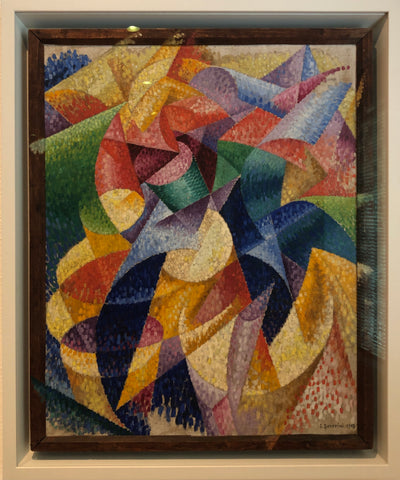Last week we were in Venice to visit the Guggenheim museum in the Palazzo Venier dei Leoni. What a beautiful museum. That alone is worth the trip to this romantic and surreal city. The abstract and surreal works from Peggy Guggenheim's collection fit there like no other city. Below is a brief history of her life and the construction of the renowned and unique collection that has influenced the art world on all sides.
The Life of Peggy Guggenheim
br>Peggy was born in 1898 in New York into a wealthy family that had become wealthy mining and smelting metals such as silver, copper and lead. In 1921 she traveled to Europe with her husband and banker Laurence Vail. Many of her acquaintances from that time, such as Constantin Brancusi and Marcel Duchamp, would become lifelong friends. The latter taught her the difference between abstract and surreal art.In 1938 she opened her first art gallery in contemporary art: Guggenheim Jeune, encouraged by Samuel Becket. The first exhibition showed works by Jean Cocteau, the second was Wassily Kandinsky's first solo exhibition in Great Britain, followed by other exhibitions of contemporary artists.
Het eerste werk dat Peggy Guggenheim kocht voor haar eigen collectie was het beeld Head and Shell van Jean Arp. In 1939 vatte Peggy het idee op om een modern museum te openen. Herbert Read, Nelly van Doesburg (de weduwe van Theo van Doesburg) en ook Piet Mondriaan waren hierin haar adviseur.
A photo a day
In 1939-40 Peggy moved to Paris and acquired many masterpieces, including Georges Braque, Salvador Dalí, Robert Delaunay, Piet Mondrian and Francis Picabia. Often for next to nothing. She bought Fernand Léger's Men in the City (1919) on the day Hitler invaded Norway. She acquired Brancusi's Bird in Space as the Germans approached Paris. Only then did she decide to flee the city to the south of France. She tried to store her works at the Louvre, but that did not work. During the war she kept a large part of her collection in the south of France.

She returned to her native New York with her children, the family of her ex Laurence Vail and her friend and artist Max Ernst, whom she married a few months later. In October 1942, Peggy opened her museum/gallery Art of This Century in Manhattan. Peggy exhibited her collection of cubist, abstract and surrealist art there and held temporary exhibitions of leading European artists. She also showed the work of many unknown young Americans at the time, such as William Baziotes, David Hare, Jackson Pollock, Mark Rothko and Clyfford Still. In 1943 she organized the first four solo performances by and for Jackson Pollock.
Abstract expressionism
Pollock and his fellow artists were among the pioneers of American abstract expressionism. The exhibition of Pollock and other avant-garde artists thus played a crucial intermediary role in the development of the first American art movement of international importance. Peggy missed Europe and wanted to return immediately after the war and decided to settle in Venice where she first exhibited her collection at the 1948 Venice Biennale, in the Greek pavilion. For example, the works of artists such as Gorky, Pollock and Rothko were exhibited in Europe for the first time. The presence of cubist, abstract and surrealist art made the pavilion the most coherent overview of modernism yet to be seen in Italy. She bought the Palazzo Venier dei Leoni and opened her house twice a week to art lovers. In the meantime, she held exhibitions in Florence, Milan and later Amsterdam, Brussels and Zurich. During those years she bought works by Edmondo Bacci, Karel Appel, Francis Bacon and others.
In 1969 she was invited by her uncle Solomon R. Guggenheim to show her collection in New York. Later, her uncle would start a foundation to manage the collection, which means it is still largely intact today. Peggy is buried in the courtyard of the Pallazzo together with many of the dogs.
In the Museum we were particularly impressed by the works of Braque, Magritte, Severini, Koenig, Calder, Kandinsky and Constantini. The visit inspired us to look for more works such as those by Jan Engelchor and Klaas Gubbels at auctions.

